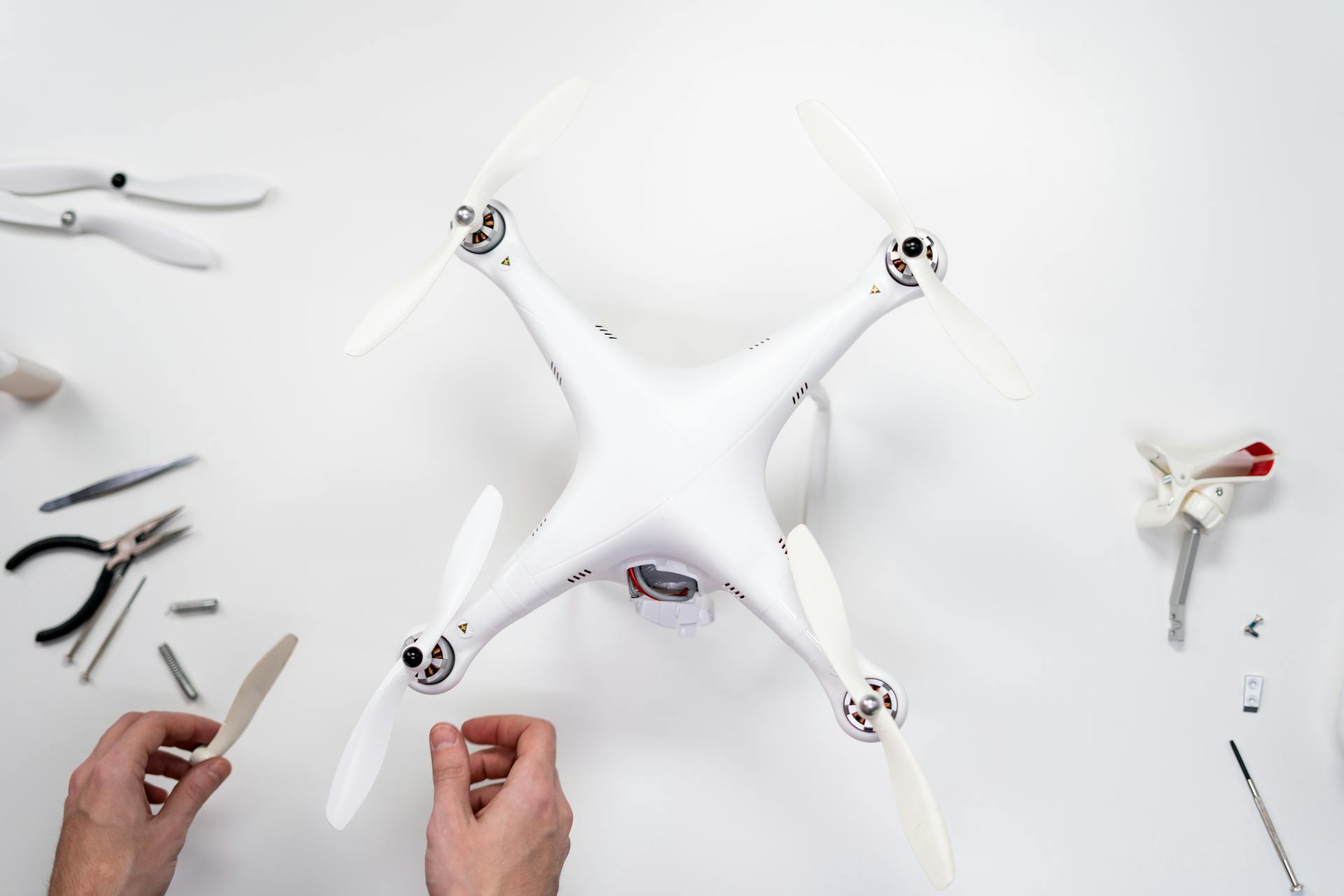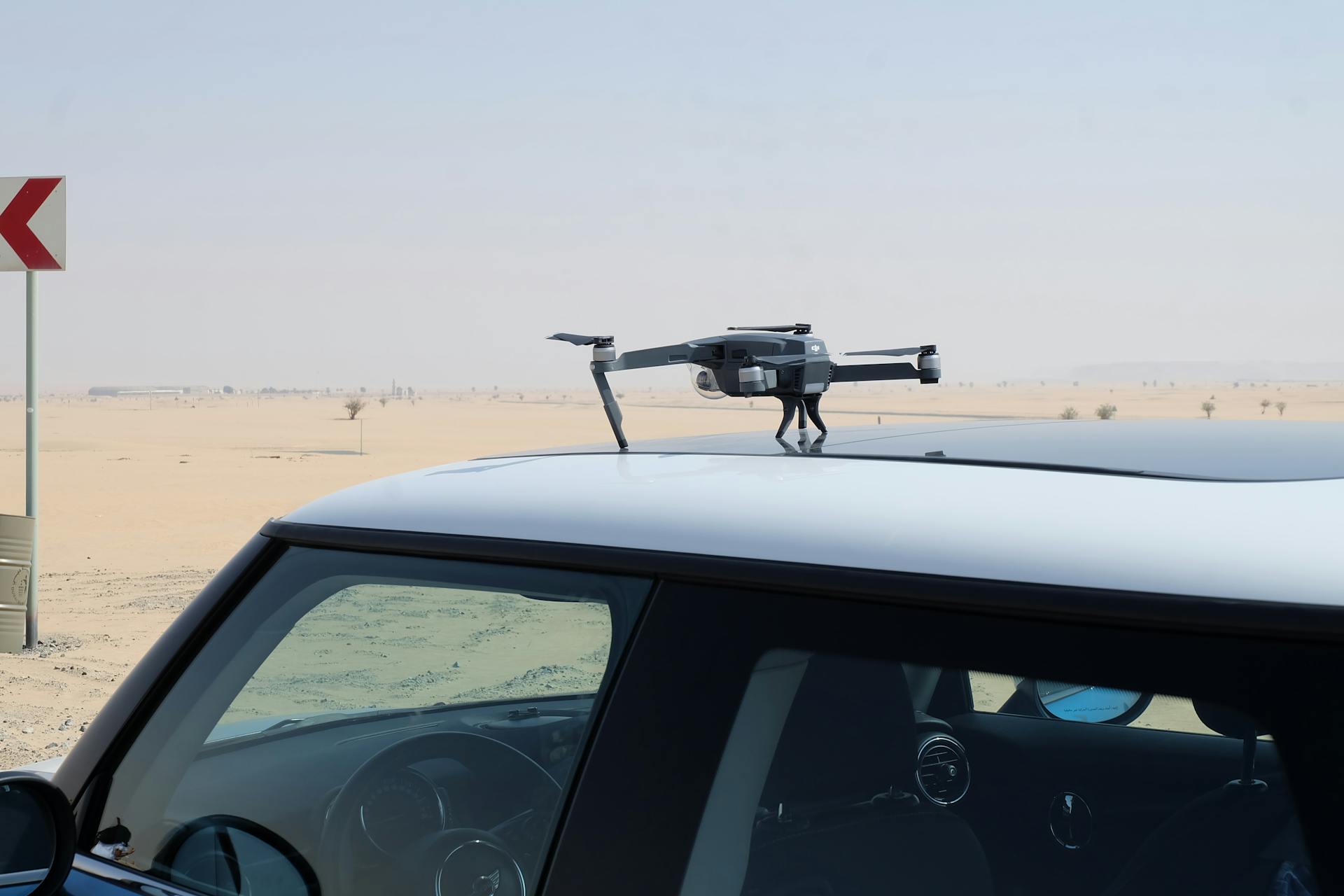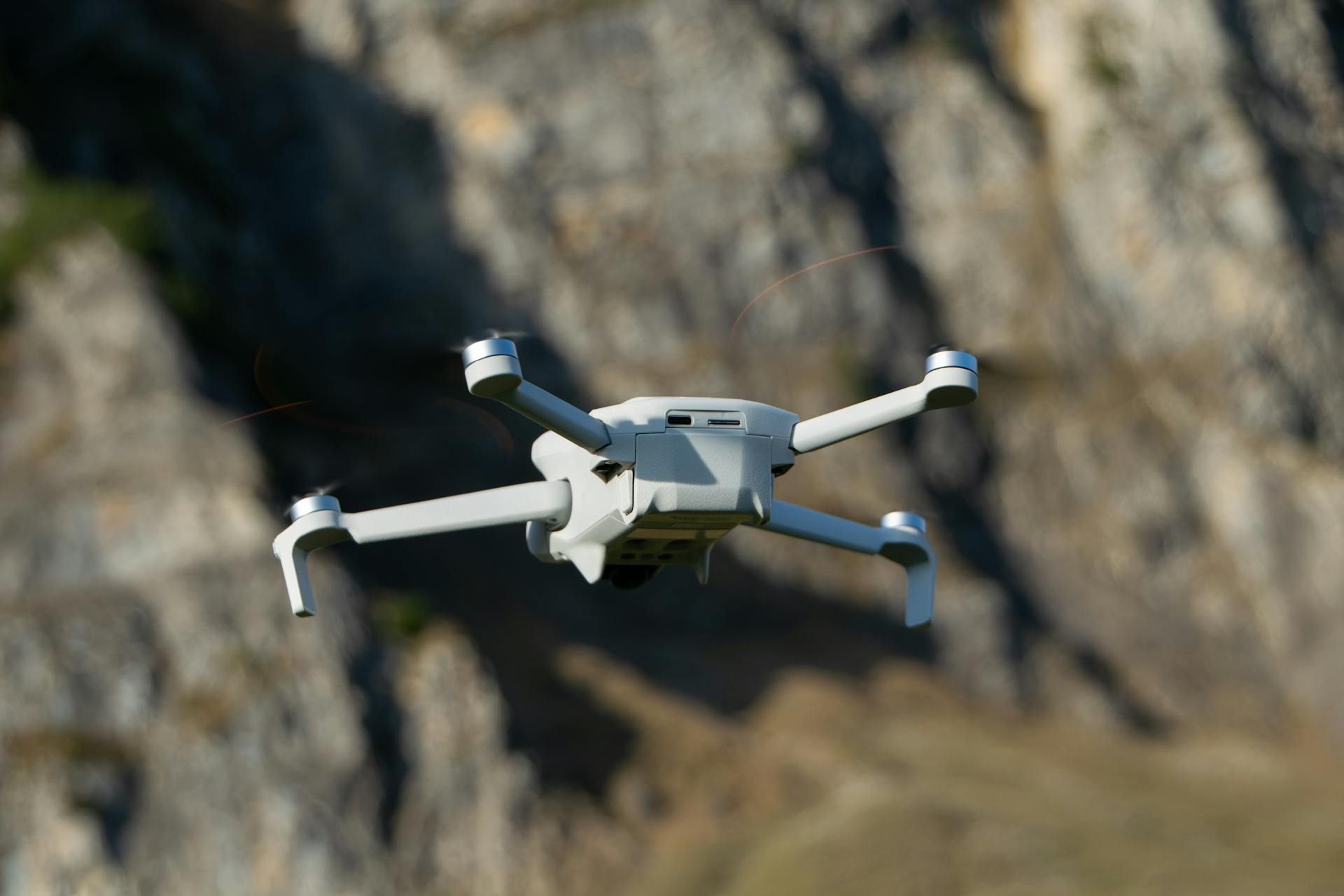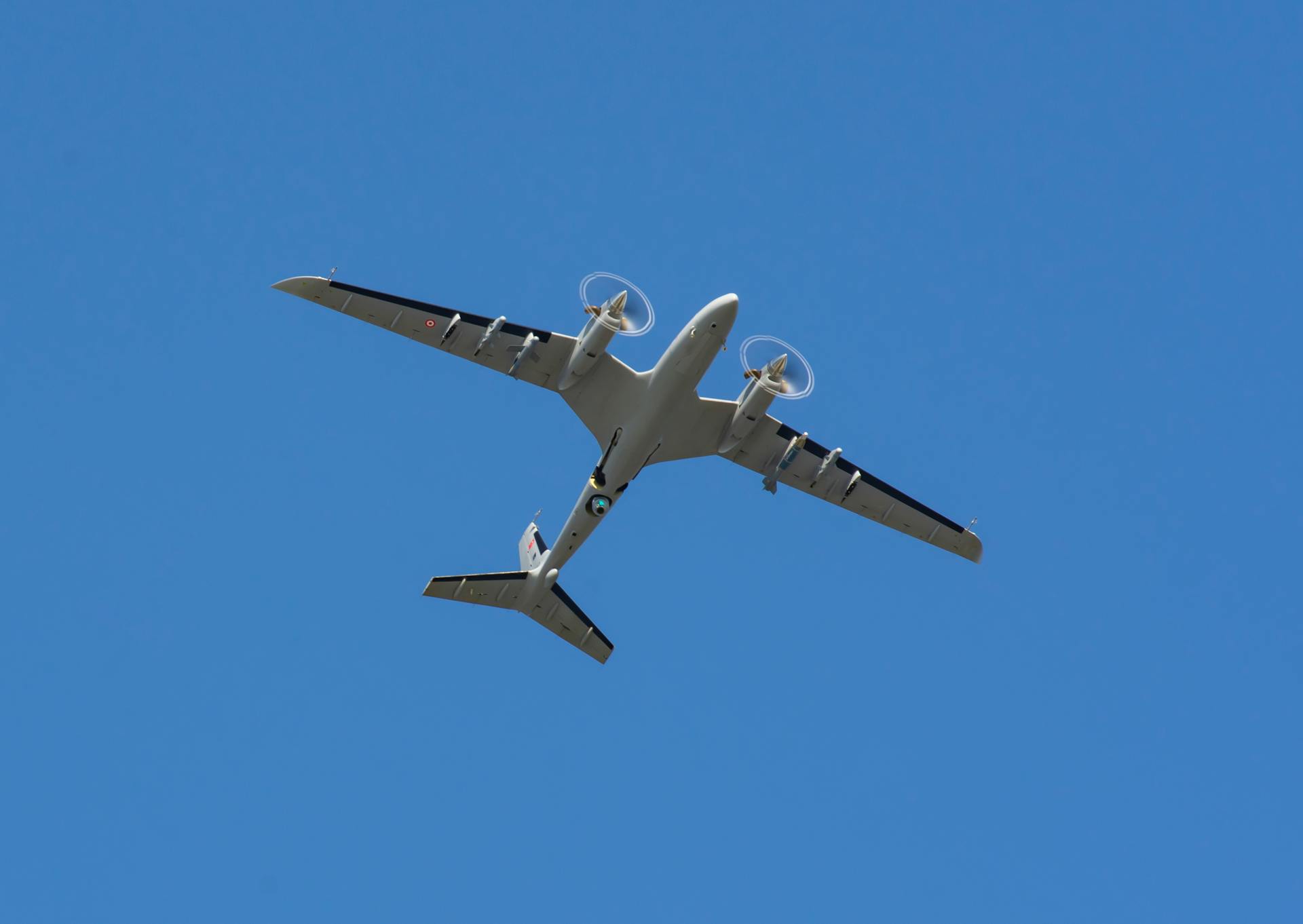
Miniature UAV systems have become increasingly sophisticated, with advancements in technology enabling them to be more compact and efficient.
These systems typically weigh less than 4.4 pounds and have a wingspan of 6.5 feet or less.
Their small size allows them to operate in confined spaces, such as indoors or in dense urban areas.
Miniature UAVs are often equipped with high-resolution cameras and sensors, enabling them to capture detailed images and data.
Their ability to operate in tight spaces makes them ideal for search and rescue missions, as well as inspection and monitoring tasks.
Additional reading: Unmanned Aircraft Systems Operations
Types of Miniature UAVs
Miniature UAVs come in various forms, each with unique capabilities. The Avian UAS, for example, has a wingspan of 1.6m and an MTOW of 3.45 kg, making it a versatile system for different missions.
Some miniature UAVs are designed for specific tasks, such as surveillance or aerial photography. The Avian UAS has been successful in monitoring disasters in Taiwan and Thailand, demonstrating its effectiveness in real-world scenarios.
MAVs, or micro air vehicles, are another type of miniature UAV. They are designed to be small, with a largest dimension of no more than 15 centimeters, and are intended for use in low-altitude, close-in support operations.
Applied Aeronautics "Albatross"
The Applied Aeronautics "Albatross UAV" is a miniature drone that resembles the military RQ-7 Shadow drone.
It's surprisingly affordable, with a price tag of less than US$2,000.
The Albatross has been used extensively in Australia, where it was showcased at the signing of a partnership between Boeing's Insitu and the Queensland Government in 2018.
Several options are available for this drone, giving users a range of choices to suit their needs.
Avian UAS
The Avian UAS is a complete unmanned aircraft system that can be customized for various missions, such as real-time surveillance, reconnaissance, and aerial photography.
It has a wingspan of 1.6m and a maximum takeoff weight (MTOW) of 3.45 kg. This system has been successfully used to monitor disasters in Taiwan and Thailand.
Avian UAS is designed to be user-friendly, allowing operators to use it with minimal training. The system can be operated in complete autonomous mode or controlled using a gamepad to adjust the heading of the UAV.
Avian UAS is a great example of how miniature UAVs can be used for real-world applications.
Mavs and Mesicopters
The notion of using small, very small, UAVs for practical purposes started gaining momentum in the early 1990s. DARPA conducted a workshop in 1992 titled "Future Technology-Driven Revolutions In Military Operations" that discussed the idea of mobile microrobots.
The RAND Corporation released a paper on the microdrone concept in 1994, which helped spread the idea. This sparked further interest and led to early engineering studies by the Lincoln Laboratories at the Massachusetts Institute of Technology (MIT) and the US Naval Research Laboratory (NRL) in Washington, D.C.
DARPA began a multi-year, US$35 million development program in 1997 to develop micro air vehicles (MAVs). MAVs were designed to be no more than 15 centimeters (5.9 in) in size, carry a day-night imager, and have an endurance of about two hours.
MAVs would operate with a high degree of autonomy, used in the squad-level combat environment. They would be capable of hovering and vertical flight, used to scout out buildings for urban combat and counter terrorist operations.
A MAV could be included in a pilot's survival kit, providing a downed pilot with a means to keep track of enemy search parties or as an airborne radio relay to search and rescue units.
Suggestion: History of Unmanned Combat Aerial Vehicles
Design and Performance
The design of miniature UAVs is a remarkable feat of engineering. The Orbiter mini UAV has a robust airframe constructed using light composite materials.
Its lightweight and agile design allows for rapid deployment in forward areas. This is especially useful for covert missions where stealth is crucial.
The electric engine of the Orbiter ensures quiet operation, making it ideal for tasks that require discretion. This is a significant advantage over traditional gasoline-powered engines.
As an autonomous Intelligence, Surveillance, Target Acquisition and Reconnaissance (ISTAR) platform, the Orbiter is designed to perform maritime missions. It can be launched and recovered from the deck of a naval ship with ease.
Ground Control and Navigation
The portable ground control station (PGCS) is a game-changer for miniature UAVs, allowing simultaneous operation of two Orbiter systems. This means you can have two UAVs in the air at the same time, with one flying in autonomous mode while the other ensures an airborne hot-swap over the target.
The Orbiter UAV can also be integrated with the one system ground control station (OSGCS), which meets NATO standardisation agreement requirements for UAV interoperability. This is a big deal for military operations, as it ensures seamless communication and coordination between different systems.
The base Orbiter ground control system features a backpack-portable, tripod-mounted omni-directional ground antenna, providing a control range of up to 15km. This is impressive, especially considering the compact size of the antenna.
The mini ground date terminal (GDT) is another option for ground control, offering a control range of up to 25km when installed on a vehicle or tripod. This is a great choice for applications where a bit more range is needed.
The UAV can autonomously perform taxi, takeoff, and landing operations with the help of onboard sensors, making it a valuable asset in GPS-denied environments.
Ground Control Station
The ground control station is a crucial component of any unmanned aerial vehicle (UAV) system. It's responsible for retrieving, processing, and storing real-time data provided by the mini UAV.
The portable ground control station features a rugged touch screen laptop/PC for mission planning, control, and payload control/image review. This setup allows operators to display flight status data and switch the UAV from manual to automatic mode.
A control screen is used for displaying flight status data and switching the UAV from manual to automatic mode. This is a critical function that requires precise control.
The ground control station is also fitted with a real-time micro-controller based system, membrane button panel, industrial joystick, power supply, and rechargeable battery unit. This setup provides a reliable and efficient way to operate the UAV.
Two crew members are required to operate the UAV from the ground control station. This highlights the importance of teamwork and coordination in UAV operations.
The Orbiter UAV can be integrated with the one system ground control station (OSGCS) developed by AAI. This meets Nato standardisation agreement requirements for the interoperability of UAVs.
A single portable ground control station allows the simultaneous operation of two Orbiter systems. This enables operators to fly two UAVs at the same time, increasing the overall effectiveness of the system.
The base Orbiter ground control system consists of a backpack-portable, tripod-mounted omni-directional ground antenna. This provides a control range of up to 15km.
You might like: Uav Flight Planning Software
The mobile auto-tracking directional planar antenna known as the mini ground data terminal (GDT) can be installed on a vehicle or tripod. It provides a control range of up to 25km.
The Orbiter UAV can also be controlled by the Standard GDT auto-tracking directional parabolic antenna system. This extends the operational control range of the UAV to 40km.
Navigation
The UAV can autonomously perform taxi, takeoff and landing operations with the help of onboard sensors. This feature is especially useful in situations where GPS is unreliable.
It can automatically return home and land safely in case of lost communication, which is a game-changer in GPS-denied environments. This ensures the UAV's safe return, even when communication is lost.
The UAV is also equipped with stall and spin control mechanism for safe flight operations.
Frequently Asked Questions
What is the smallest military UAV?
The Teledyne FLIR Black Hornet Nano is the smallest military UAV, measuring just 3 inches in length and weighing 1.1 ounces. This tiny drone is designed for covert surveillance and reconnaissance missions, providing a unique advantage on the battlefield.
What is a micro UAV?
A Micro UAV is a small, portable drone that operates at low altitudes for close-in support. Its compact size makes it ideal for tactical missions and surveillance operations.
What is the range of the mini UAV?
The Aladin Mini-UAV has a range of over 15 km. Its extended range allows for versatile deployment in various military operations.
Featured Images: pexels.com


